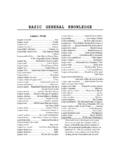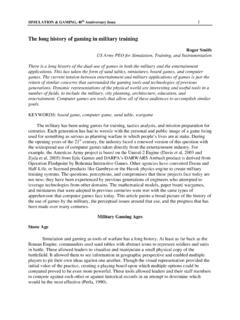Transcription of Gurdjieff and Prince Ozay - 2004
1 Copyright 2004, Paul Beekman Taylor Retrieved from 1 Gurdjieff and Prince ozay Paul Beekman Taylor Gurdjieff was a man of many masks. Professor Taylor examines the conflicting evidence surrounding whether or not ozay was one of Gurdjieff s personas. Gurdjieff was a man of many parts and many roles. How many different nominal identities he adopted during his life has been particularly difficult for his biographers to tally. On the one hand, Rom Landau s identification of Gurdjieff with Agwan Dordjieff, based on the testimony of Achmed Abdullah,1 is easily argued away by James Webb;2 and Webb s identification of Gurdjieff with Ush Narzunoff is put in doubt by James On the other hand, Webb considers that the description of Prince ozay by Paul Dukes (1889 1967) replicates the description of Gurdjieff in Glimpses of Truth, 4 and Moore takes the identification of the two as As Webb has it, one account which seems to describe Gurdjieff on a mysterious errand, accompanied by a slant-eyed friend in St.
2 Petersburg during the winter and early spring of 1913 14, is contained in the autobiography of Sir Paul Dukes. (p. 49). Dukes story is in Chapter 7 of his text entitled The Lord s Prayer, where Dukes recalls that his acquaintance and fellow hypnotist, Lev ( Lion ) Lvovitch (Webb s form is Levovitch) offered to introduce him to a person in hiding, of whom there are but few in the world. He led Dukes to a house at the bottom of a small street not far from the Nicholas station (p. 99) where, in an exotic setting, they found two men playing chess. One, thickset, with a short bushy beard, dark piercing eyes sparkling with humour, and wearing a turban and silk dressing gown, greeted them in Russian with a marked accent (p.)
3 100). He spoke English better than Russian, rather correctly and with less accent (p. 101) 1 God Is My Adventure (1935). 2 The Harmonious Circle (1980), pp. 49 51, where he cites the disclaimer first made in the 1930s by Alexandra David-Neel. 3 Gurdjieff : The Anatomy of a Myth (1991), p. 341. In recent correspondence, Moore has told me that Narzunoff and Dordjieff were together at the All-Soviet Congress of Buddhists, 20 28 January, 1927, while Gurdieff was comfortably ensconced in France. 4 Webb, pp. 84 87, Moore, pp. 74 76, Sir Paul Dukes, The Unending Quest: Autobiographical Sketches (1950), pp. 99 113. 5 By 1913, Gurdjieff was teaching Paul Dukes under the assumed name Prince ozay (p.
4 341). Copyright 2004, Paul Beekman Taylor Retrieved from 2 After Lev told of Dukes success in curing peasant ailments by hypnotic suggestion, the turbaned man asked to hear his performance of the Lord s Prayer that figured in his cures. Dukes did so, but his interlocutor said that the breath taken in the middle of the prayer was wrong, then proceeded to chant the prayer himself with no halt for breath .. it was one single sound (p. 101). Dukes felt the penetrating effect of the chanted fading note, and his host explained that a chanted prayer is measure of a single trained breath, and that the Lord s Prayer is designed as a breathing exercise. Christ was a teacher of prayer, and prayer is associated with fasting.
5 Breath is sound and words, he said, but In the modern religion of the West, which has degenerated into hopeless institutional formalism, the words are mistaken for the whole thing .. I have been in many churches in England and America, said my mysterious host, and always heard the congregation mumble the Lord s Prayer all together in a scrambled grunt as if the mere muttered repetition of the formula were all required..However alike in appearance, we are all constructed more or less differently from each other. It is closely concerned with how a man breathes, and no two persons breathe exactly alike (p. 102). He continued: Nobody thinks of teaching children how to breathe nobody, that is, outside certain limited circles.
6 Prayer in is highest form would seem after all to have something to do with the digestion and even with the quality and circulation of the blood (p. 103). His host gave Dukes an example of the physical force of prayer by having him feel the base of his chest while he pronounced the mantra OM. After the conclusion of the chess games, the four turned to telling ribald stories, while the host sung to a sort of guitar (p. 105). The slant-eyed man with the goatee spoke no English and little Russian. A mulatto servant brought in drink and food. Dukes noticed now that his host was of medium height, sturdily built and after they left that evening, Lev advises: Call him Prince ozay .
7 Dukes was intrigued by the mystery of ozay s identity. He seemed to him either Moslem or Parsee. ozay loved music ..It was the musical side of what he had to say the subject of chanting on a single breath which most engrossed me, though I soon learned that this was bound up inextricably with everything else physique, physics, philosophy. But he was not always easy to draw out. As a rule he was provokingly evasive .. I try to get in a word about the matter that so much interests me but he wants to play chess (p. 106) When Dukes returned to the subject at a subsequent meeting, ozay said that the phrase in the Lord s Prayer Hallowed be thy name referred to the Name, or Logos Then what was the logos A sound.
8 The first sound .. What you might call the world s tonic note (p. 107). Fasting incites discovery of the name/logos. The sound is felt, since unheard sounds are most penetrable. Listen inwardly, ozay said, and hear the blood like a cascade. Prayer is built on diet, breath and sex. The function of prayer is to attune the body: Nobody can ever hope to attune himself perfectly in whom sex is weak, or undeveloped, or unbalanced, or abnormal (p. 108). Incantation of prayer is the science of Mantra. It is the esoteric side of Christianity (p. 109). To give Dukes Copyright 2004, Paul Beekman Taylor Retrieved from 3an experience of such prayer, ozay instructed him to listen to a priest sing mass in the Orthodox Church.
9 After Dukes later reported his observations, ozay remarked: in a few year, if you are persistent, you will note the results. To Dukes expression of impatience, ozay warned him that truth must always be revealed in small doses, greatly diluted. And sound too, has to be rationed, especially the Name which is above every name, as your scriptures express it. That is why the Name must be hallowed. An overdoes might easily kill you before you re trained for it.. Young man, he said sternly, I could kill you in an instant, sitting here, without either of us moving a muscle .. Understand this clearly. No man can acquire this kind of knowledge without risking death. God misapplied is the Devil.
10 There is only one force in creation. Good and evil lie merely in its application (p. 113). Webb s speculation about ozay s real identity derives from his apparent similarity to the figure of Gurdjieff in Glimpses of Truth, the lead essay in Views From the Real World, 6 that tells of an anonymous pupil s visit and private conversion outlining Gurdjieff s system. in the course of a single sitting. The Gurdjieff of Glimpses begins his expos in a rough Russian which becomes more fluent to the listener as time The instruction of a single pupil in an exotic setting, the striking appearance of the teacher, particularly his eyes, medium height, his regard for music and his disdain for abnormal sex all inform Webb s conclusion that it seems difficult to believe that there were two such teachers in the same area at the same time (p.)




